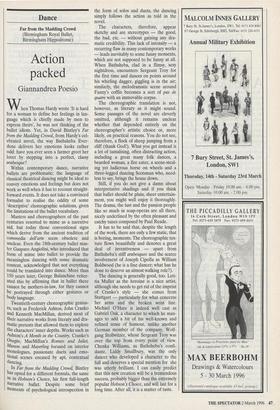Dance
Far from the Madding Crowd (Birmingham Royal Ballet, Birmingham Hippodrome)
Action packed
Giannandrea Poesio
When Thomas Hardy wrote 'It is hard for a woman to define her feelings in lan- guage which is chiefly made by men to express theirs', he was not thinking of the ballet idiom. Yet, in David Bintley's Far from the Madding Crowd, from Hardy's cel- ebrated novel, the way Bathsheba Ever- dene delivers her emotions looks rather odd: have you ever seen a farmer greet her lover by stepping into a perfect, classy arabesque?
Within contemporary dance, narrative ballets are problematic; the language of classical theatrical dancing might be ideal to convey emotions and feelings but does not work as well when it has to recount straight- forward events. It does not take a convinced formalist to realise the oddity of some `descriptive' choreographic solutions, given the limitations of the ballet vocabulary.
Masters and choreographers of the past centuries resorted to mime as a narrative aid, but today those conventional signs which derive from the ancient tradition of commedia dell'arte seem obsolete and unclear. Even the 18th-century ballet mas- ter Gasparo Angiolini, who introduced that form of mime into ballet to provide the meaningless dancing with some dramatic content, acknowledged that not everything could be translated into dance. More than 150 years later, George Balanchine reiter- ated this by affirming that in ballet there cannot be mothers-in-law, for they cannot be portrayed through either gestures or body language.
Twentieth-century choreographic genius- es, such as Frederick Ashton, John Cranko and Kenneth MacMillan, derived most of their narrative works from literary and dra- matic pretexts that allowed them to explore the characters' inner depths. Works such as Ashton's A Month in the Country, Cranko's Onegin, MacMillan's Romeo and Juliet, Manon and Mayerling focused on interior monologues, passionate duets and emo- tional scenes encased by apt, contextual dancing. In Far from the Madding Crowd, Bintley has opted for a different formula, the same as in Hobson's Choice, his first full-length narrative ballet. Despite some brief moments of psychological introspection in the form of solos and duets, the dancing simply follows the action as told in the novel.
The characters, therefore, appear sketchy and are stereotypes — the good, the bad, etc. — without gaining any dra- matic credibility. This lack of intensity — a recurring flaw in many contemporary works — leads inevitably to some funny moments, which are not supposed to be funny at all. When Bathsheba, clad in a flimsy, sexy nightdress, encounters Sergeant Troy for the first time and dances on points around his whirling dagger, giggling is in the air; similarly, the melodramatic scene around Fanny's coffin becomes a sort of pas de quatre with an immovable corpse.
The choreographic translation is not, however, as literary as it might sound. Some passages of the novel are cleverly omitted, although it remains unclear whether that depended entirely on the choreographer's artistic choice or, more likely, on practical reasons. You do not see, therefore, a flock of sheep jumping from a cliff (thank God!). What you get instead is a lot of tantalising, often distracting action, including a great many folk dances, a bearded woman, a fire eater, a scene-steal- ing yet ludicrous horse on wheels and a three-legged dancing Scotsman who, need- less to say, brings the house down.
Still, if you do not give a damn about interpretative shadings and if you think that ballet should be plain, sheer entertain- ment, you might well enjoy it thoroughly. The drama, the lust and the passion people like so much in soap-operas are all there, nicely underlined by the often pleasant and catchy tunes composed by Paul Reade.
It has to be said that, despite the length of the work, there are only a few static, that is boring, moments. The choreographic tex- ture flows beautifully and denotes a great deal of inventiveness — apart from Bathsheba's stiff arabesques and the scarce involvement of Joseph Cipolla as William Boldwood (he is a fine dancer; what has he done to deserve an almost walking role?).
The dancing is generally good, too. Leti- tia Muller as the heroine is a nice artist, although she needs to get rid of the imprint of Cranko's style — she comes from Stuttgart — particularly for what concerns her arms and the broken wrist line. Michael O'Hare is indeed well cast as Gabriel Oak, a character to which he man- ages to add a bit of his well-known and refined sense of humour, unlike another German member of the company, Wolf- gang Stollwitzer, whose Sergeant Troy was over the top from every point of view. Chenka Williams, as Bathsheba's confi- dante, Liddy Smallbury, was the only dancer who developed a character to the full and deserves a special mention for she was utterly brilliant. I can easily predict that this new creation will be a tremendous success, probably bigger than the extremely popular Hobson's Choice, and will last for a long time. After all, it is a matter of taste.


































































 Previous page
Previous page